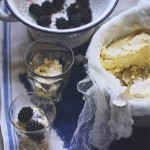 How lovely to hear that Ballymaloe Cookery School is to hold a two and a half day Practical Cookery Course, Traditional Irish Cooking with Darina Allen, Rachel Allen and Rory O’Connell next week (Wednesday, 29th to Friday, 31st August 2012).
How lovely to hear that Ballymaloe Cookery School is to hold a two and a half day Practical Cookery Course, Traditional Irish Cooking with Darina Allen, Rachel Allen and Rory O’Connell next week (Wednesday, 29th to Friday, 31st August 2012).
Like Irish food and Irish farming, Irish traditional cooking is coming back into its own at last and it’s great to see it. After decades in the wilderness, when ‘expert opinion’ so often decreed that there was no such thing as an ‘Irish cuisine’ and multicultural cooking took centre stage, our delicious country dishes are back on the menu and being freshly appreciated once more for their homely simplicity and relevance to our climate, farming and culture.
 Darina Allen has been one of the most dedicated champions of traditional Irish cooking over many years, and she’s travelled far and wide throughout the country, researching and recording the recipes and regional dishes that became the backbone of her 1995 book, Irish Traditional Cooking. An updated edition was published this year and it is now the inspiration for this course.
Darina Allen has been one of the most dedicated champions of traditional Irish cooking over many years, and she’s travelled far and wide throughout the country, researching and recording the recipes and regional dishes that became the backbone of her 1995 book, Irish Traditional Cooking. An updated edition was published this year and it is now the inspiration for this course.
So, if you’d enjoy finding out about Ireland’s wealth of culinary history – then this course ‘concentrating on the real Irish Cooking of generations’ is the place for you.
Expect some wonderful recipes and delightful stories. Find out how Darina learned to cook apple cake in a bastible on an open fire from Joan Twomey in County Cork, for example, or how she collected bairneachs (limpets) off the rocks at Ballyheigue in County Kerry to make the traditional Good Friday Soup. Fascinating stuff and it’s bound to be great fun too.
Details from: Ballymaloe Cookery School Shanagarry Co Cork
Tel + 353 21 4646785; www.cookingisfun.ie
RECIPES from Irish Traditional Cooking:
Whereas Leitrim and the Drumlin area seem to be the home of boxty, it crops up in many other places around the country under various names. In Co. Wexford and Co. Tipperary I was given recipes for ‘grated cakes in the pan’, both of which were essentially pan boxty. Granny Toye from Clones, Co. Monaghan, now 88 years of age, gave this recipe to me. Granny Toye says that pan boxty may be eaten hot or cold and may be reheated. A tablespoon of fresh herbs provides a delicious, if untraditional, flavouring to the dish.
Serves 4
6 medium potatoes
a handful of white flour
salt
butter, for frying
Scrub the potatoes well, but don’t peel. Line a bowl with a cloth. Grate the potatoes into the cloth, then squeeze out the liquid into the bowl and allow it to sit for about 20 minutes until the starch settles.
Set the potatoes aside. Drain off the water and leave the starch in the bottom of the bowl.
Add the grated potato, a handful of white flour and some salt. Melt a nice bit of butter on a heavy iron pan and pour in the potato mixture. It should be 2–2.5cm (¾–1in) thick.
Cook on a medium heat. Let it brown nicely on one side before turning over and then on the other side, about 30 minutes in all, depending on the heat. It’s much better to cook it too slowly rather than too fast. It should be crisp and golden on the outside. Cut the boxty into four farls and serve.
The simplest of all cheeses made in the time-honoured way.
Makes 450g (1lb) cheese (approximately)
2.3 litres (4 pints) whole milk
¼–½ teaspoon liquid rennet
good-quality muslin or cheesecloth
Put the milk into a spotlessly clean, heavy-based stainless-steel saucepan. Heat it very gently over a low heat until barely tepid.
Stir the rennet well into the milk, not more than ½ teaspoon – too much will result in a tough acid curd.
Cover the saucepan with a clean tea towel and the lid. The cloth prevents the steam from condensing on the lid of the pan and falling back on to the curd.
Put the pan to one side and leave undisturbed in your kitchen for 2–4 hours. The milk should then have coagulated and will be solid.
Cut the curd with a long sterilized knife and heat gently on a low heat for a couple of minutes until the whey starts to run. It must not get too hot or the curd will tighten and toughen too much. Ladle into a muslin-lined colander over a bowl.
Tie the corners of the muslin and allow the curd to drip overnight. Next day it can be eaten with soft brown sugar and cream, or freshly picked soft fruit from the garden, or wild fruit such as blackberries in season.










